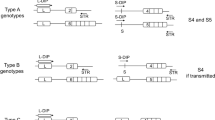Abstract
Prenatal paternity analysis can be performed only after invasive sampling of chorionic villi or amnionic fluid. Aiming to enable noninvasive paternity testing, we attempted to amplify fetal alleles from maternal plasma. Cell-free DNA was isolated from plasma of 20 pregnant women and amplified with ampFLSTR Identifiler and ampFLSTR Yfiler kits. Unfortunately, autosomal fetal alleles were heavily suppressed by maternal DNA, and the only locus that was reliably amplified with AmpFLSTR Identifiler kit was amelogenin, which revealed only fetal gender. Much better success was obtained with AmpFLSTR Yfiler kit, which, in the case of male fetuses, successfully amplified between six and 16 fetal loci. All amplified fetal alleles matched the alleles of their putative fathers, confirming the tested paternity. To the best of our knowledge, this is a first report of noninvasive prenatal paternity testing.

Similar content being viewed by others
References
Bianchi DW (1999) Fetal cells in the maternal circulation: feasibility for prenatal diagnosis. Br J Haematol 105:574–583
Birch L, English CA, O’Donoghue K, Barigye O, Fisk NM, Keer JT (2005) Accurate and robust quantification of circulating fetal and total DNA in maternal plasma from 5 to 41 weeks of gestation. Clin Chem 51:312–320
Biruš I, Marcikić M, Lauc D, Džijan S, Lauc G (2003) How high should paternity index be for reliable identification of war victims by DNA typing? Croat Med J 44:322–326
Brinkmann B, Pfeiffer H, Schurenkamp M, Hohoff C (2001) The evidential value of STRs. An analysis of exclusion cases. Int J Leg Med 114:173–177
Budimlija ZM, Prinz MK, Zelson-Mundorff A et al (2003) World Trade Center human identification project: experiences with individual body identification cases. Croat Med J 44:259–263
Gornik I, Marcikić M, Kubat M, Primorac D, Lauc G (2002) The identification of war victims by reverse paternity is associated with significant risks of false inclusion. Int J Leg Med 116:255–257
Guetta E (2006) Noninvasive detection of fetal sex: the laboratory diagnostician’s view. Prenat Diagn 26:635–636
Jakovski Z, Nikolova K, Furac I, Masic M, Janeska B, Kubat M (2006) Allele frequencies for 15 STR loci in a population from the Republic of Macedonia. Int J Leg Med 120:53–55
Lo YM (2005) Recent advances in fetal nucleic acids in maternal plasma. J Histochem Cytochem 53:293–296
Lo YM, Corbetta N, Chamberlain PF, Rai V, Sargent IL, Redman CW, Wainscoat JS (1997) Presence of fetal DNA in maternal plasma and serum. Lancet 350:485–487
Lo YM, Zhang J, Leung TN, Lau TK, Chang AM, Hjelm NM (1999) Rapid clearance of fetal DNA from maternal plasma. Am J Hum Genet 64:218–224
Primorac D, Schanfield MS (2000) Application of forensic DNA testing in the legal system. Croat Med J 41:32–46
Thomson JA, Ayres KL, Pilotti V, Barrett MN, Walker JI, Debenham PG (2001) Analysis of disputed single-parent/child and sibling relationships using 16 STR loci. Int J Legal Med 115:128–134
Tong YK, Lo YM (2006) Diagnostic developments involving cell-free (circulating) nucleic acids. Clin Chim Acta 363:187–196
Turrina S, Atzei R, De Leo D (2006) Y-chromosomal STR haplotypes in a Northeast Italian population sample using 17plex loci PCR assay. Int J Leg Med 120:56–59
Wagner J, Dzijan S, Pavan-Jukic D, Wagner J, Lauc G (2008) Analysis of multiple loci can increase reliability of detection of fetal Y-chromosome DNA in maternal plasma. Prenat Diagn 28:412–416
Acknowledgments
This work was supported by grants 219-0061194-2023 and 309-1300855-2738 from the Croatian Ministry of Science, Education and Sport.
Financial interest
None declared.
Author information
Authors and Affiliations
Corresponding author
Electronic supplementary material
Below is the link to the electronic supplementary material.
ESM 1
(PDF 746 kb)
ESM 2
(PDF 807 kb)
ESM 3
(PDF 756 kb)
ESM 4
(PDF 766 kb)
ESM 5
(PDF 835 kb)
ESM 6
(PDF 711 kb)
ESM 7
(PDF 701 kb)
ESM 8
(PDF 709 kb)
ESM 9
(PDF 574 kb)
ESM 10
(PDF 695 kb)
ESM 11
(PDF 562 kb)
ESM 12
(PDF 568 kb)
ESM 13
(PDF 555 kb)
ESM 14
(PDF 709 kb)
ESM 15
(PDF 806 kb)
ESM 16
(PDF 747 kb)
ESM 17
(PDF 742 kb)
ESM 18
(PDF 835 kb)
ESM 19
(PDF 701 kb)
ESM 20
(PDF 704 kb)
ESM 21
(PDF 574 kb)
ESM 22
(PDF 624 kb)
ESM 23
(PDF 579 kb)
ESM 24
(PDF 588 kb)
ESM 25
(PDF 647 kb)
ESM 26
(PDF 555 kb)
ESM 27
(PDF 553 kb)
Supplementary Table
(XLS 28 kb)
Supplementary electropherograms
(DOC 51 kb)
Rights and permissions
About this article
Cite this article
Wagner, J., Džijan, S., Marjanović, D. et al. Non-invasive prenatal paternity testing from maternal blood. Int J Legal Med 123, 75–79 (2009). https://doi.org/10.1007/s00414-008-0292-9
Received:
Accepted:
Published:
Issue Date:
DOI: https://doi.org/10.1007/s00414-008-0292-9




